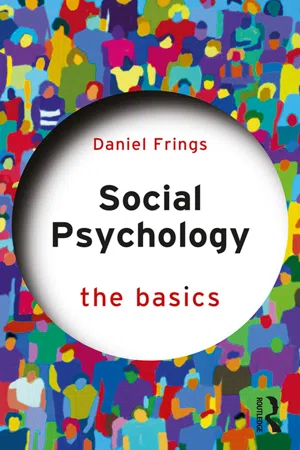Psychology
Resistance to Social Influence
Resistance to social influence refers to the ability of individuals to withstand pressure from others to conform or comply with their views, beliefs, or behaviors. This resistance can be influenced by factors such as confidence, self-esteem, and the presence of dissenting voices. Understanding resistance to social influence is important for comprehending individual autonomy and the dynamics of group behavior.
Written by Perlego with AI-assistance
Related key terms
4 Key excerpts on "Resistance to Social Influence"
- eBook - ePub
Resistance to Belief Change
Limits of Learning
- Joseph R. Lao, Jason Young(Authors)
- 2019(Publication Date)
- Routledge(Publisher)
8Social Influences on ResistanceOverview
We defined learning above as the process by which we acquire new information. But what is it that determines whether a new piece of information will be warmly received or coldly rejected? So far, the answer we explored in the last few chapters has focused on the inner dynamics of the individual, including our mental framework and our preexisting beliefs. Recall that our mental framework at any waking moment reflects an interactive nexus between the inner and outer contexts of our behavior, that is, between our external environment and the beliefs that make up our mental framework. Of all the different factors in our environment, one of the most powerful influences on our behavior comes from other people, in the form of social norms and pressures from those around us. While our inner life focuses on maintaining a sense of order among our beliefs, our outer life reflects concerns how we appear and relate to others, an inherent priority given humans’ social nature.It is important to acknowledge that resistance frequently occurs in a social environment that has the power to influence the likelihood resistance will occur. Indeed, most people find it socially embarrassing or intra-personally disruptive to admit they are wrong. Many worry that people who frequently change their beliefs will be perceived as fickle, indecisive, weak, or even unstable. And those whose beliefs deviate too much from the norms of their social group run the risk of being sanctioned, imprisoned (as was Galileo), or even executed (as was Socrates). Such social pressures may compel us to resist new and different information, thereby reinforcing adherence to our existing beliefs. Therefore, this chapter explores various social factors that may influence the type and degree of resistance to new information and belief change. - eBook - ePub
Principles of Social Psychology
Third Edition
- Kelly G. Shaver(Author)
- 2015(Publication Date)
- Psychology Press(Publisher)
You get accustomed to a particular way of perceiving the social environment, to a set of social attitudes, or to a pattern of interpersonal behavior, and it requires a special effort to change away from that routine. You may not even claim that your way is the best way, only that it is comfortable for you. This behavioral inertia is a nonspecific sort of Resistance to Social Influence: It will act as a counterforce to any influence attempt, no matter what the direction of the applied force. In contrast to the nonspecific character of inertia, resistance is a counterforce specifically induced by the nature of the influence attempt. Resistance, like reactance, is a response to a threatened freedom. But it is produced by an attempt to change your actions from what they would have been without influence, rather than an attempt to require you to do what you were already about to do. What would it mean to change in the direction advocated by the powerful person? By accepting influence, you not only change your behavior, you also imply that future influence attempts by the same powerful agent will be successful. You sacrifice a certain amount of personal freedom, and the greater the threatened freedom, the greater the resistance. Suppose that two people ask you to change one of your behaviors; one of the influencing agents is a person you will never see again, whereas the other is a person with whom you interact on a regular basis. Both requests will produce the same degree of counterforce from inertia, but the second will produce the greater resistance. Thus, resistance is the social-influence counterpart of reactance. Avoidance and Opposition. A third response to the influence attempt is to leave the situation entirely. This avoidance response is not so much a true counterforce to the influence attempt as it is a demonstration that the powerful person cannot even force you to subject yourself to continued pressure - eBook - ePub
Getting Grounded in Social Psychology
The Essential Literature for Beginning Researchers
- Todd D. Nelson(Author)
- 2017(Publication Date)
- Psychology Press(Publisher)
The other day, I took my family to Fisherman’s Wharf, a famous tourist attraction in San Francisco, CA. In addition to the museums, shops, sea lions, clam chowder, and unparalleled views of the San Francisco Bay, this area is known for its many colorful buskers—people who perform on the street in exchange for a cash donation from tourists. I came prepared to tip any buskers that entertained my family, as I grew up in the area and was familiar with the social norms—cultural rules of conduct—associated with Fisherman’s Wharf. What I did not expect was to be manipulated out of my money by a man selling his music CDs on the street. As I walked by him, the aspiring musician handed me one of his albums on CD. I took it, thinking it was free and thanked him. When the young man followed up by asking me for a cash donation to at least cover the cost of the materials (CD, labels, etc.), I should have given it back. I really should have. I did not want the CD in the first place and never would have taken it had I realized up front that he wanted money for it. But at the same time, I was distracted by the busy, overcrowded place and was focused on keeping track of my kids. I also did not want to be rude by returning a “gift.” So, I took the smallest bill out of my wallet—$10—and gave it to him. What I should have remembered in the first place is illustrated in the above quote: TANSTAAFL (There ain’t no such thing as a free lunch), a lesson I regularly teach my students. However, as the present chapter will illustrate, even those of us who ought to know better sometimes succumb to social influence appeals.Social influence occurs when a person changes his or her attitudes or behavior as a result of external pressure (Cialdini, 2009). This external pressure may be real or may be in the mind of the person influenced. Nonetheless, decades of research has illustrated that as long as people feel (consciously or unconsciously) the pressure to change, the veracity of the pressure is in the mind of the beholder. On a daily basis, people are exposed to countless social influence attempts from a variety of sources. For example, on a typical day, we might be presented with requests to apply for a credit card, advertisements attempting to convince us to purchase certain consumer products, communications from political candidates seeking our vote, or vivid stories from our friends compelling us to join them in purchasing an activity, product, or service. Thus, social influence is an area of social psychology that affects us all.How do people decide which social influence appeals to attend to? How do people discern the difference between a legitimate request and one that is manipulative in manner? Are certain people more or less susceptible to social influence appeals? And if yes, what makes the resistant different from the influenceable? Are there situational factors that impact our influenceability? These are just some of the questions research in social influence has examined over the years. In this chapter, I review both classic and current research on social influence, highlighting some of the most influential research in this area.Generally, within the social influence literature, scholars suggest that there are two types of social influence: persuasion and compliance (Cialdini, 2009). Persuasion—the cognitive component of social influence—occurs when people change their attitudes, opinions, and/or beliefs as a result of social influence. Compliance—the behavioral component of social influence—refers to a change in behavior as a result of social influence. While common sense suggests that people’s attitudes are related to their behavior, the results from years of social psychological inquiry indicate that this is not always the case (for more details, see Ajzen, 2011; Glasman & Albarracín, 2006). The anecdote from the beginning of the chapter provides one such example where social influence occurred (i.e., I complied with the request for cash in exchange for the music CD), but that did not persuade me to adopt a positive attitude about the musician nor his music. Indeed, as soon as I returned home, the CD ended up in the trash. Thus, some instances of social influence may provide short- (but not long-) term gains. While the majority of this chapter will review the extant research on compliance and other behavioral forms of social influence, I would be remiss if I did not also review the essentials of persuasion as well. - eBook - ePub
Social Psychology
The Basics
- Daniel Frings(Author)
- 2018(Publication Date)
- Routledge(Publisher)
Social influence Theme overviewHow would you behave if told to do something you fundamentally disagreed with? How do revolutionary movements overturn the opinions of the society they exist in? When you see an advert promoting a new product, how good are you at separating the facts from the marketing spiel? Do others invigorate you to work harder, or do you just blend in and slack off? All of these phenomena can broadly be understood as instances where social influence comes into play.In many ways, the study of social influence encompasses all of social psychology. Recall that the impact of the ‘actual, imagined or implied’ presence of others is part of how we define the field. In essence, when someone’s actions (or something which signifies such actions) changes how someone else thinks, feels or behaves, you can argue social influence has taken place. As such, our discussion of social influence encompasses almost every page of this book. However, we can also narrow the discussion by looking at how people change the intended behaviour of others (which we discuss in Chapter 6 , ‘Conformity and obedience’) and how we are both recipients of, and targets for, people’s attempts to change our opinions on a given issue (explored in Chapter 7 , ‘Persuasion’).Across these two chapters we will explore how, why and when we conform to others’ demands, the effects of groups on our performance, how society deals with people who won’t conform to the prevailing view and how such minorities can cause major social shifts. We also explore the theory and practice of persuasion by investigating the extent to which we are rational thinkers, how irrelevant information such as mood and colour influence us, and how the science of persuasion is applied to marketing and public policy.
Index pages curate the most relevant extracts from our library of academic textbooks. They’ve been created using an in-house natural language model (NLM), each adding context and meaning to key research topics.



